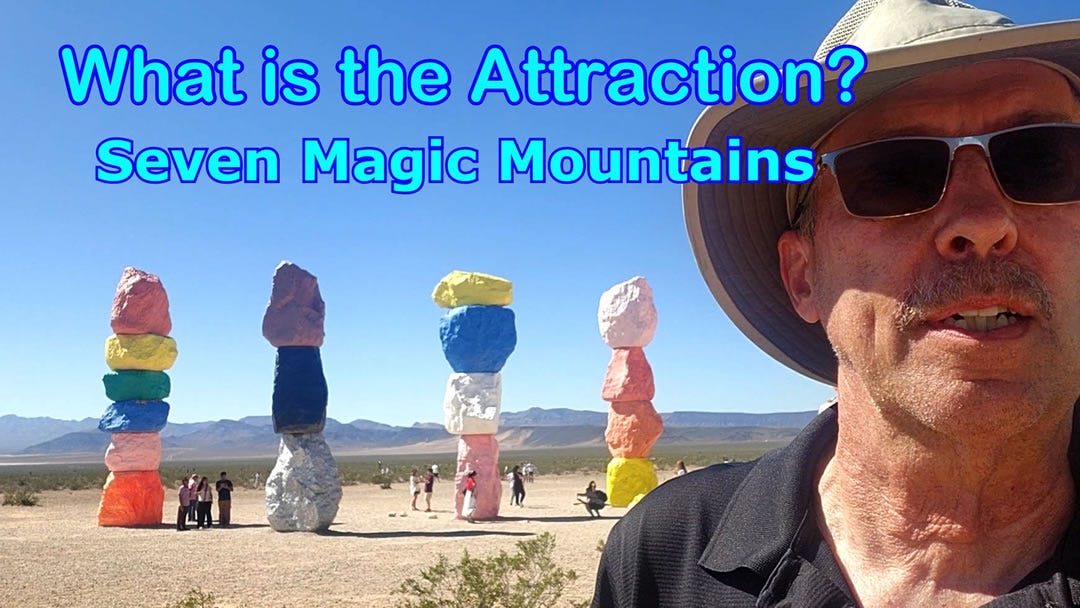Seriously. What's the attraction to Seven Magic Mountains?
Out in the glorious, sun-blasted vacuum of the Mojave Desert, approximately three Uber surges away from the nearest non-ironic cocktail, stands a sight so profound it practically screams, “I am a contemporary art installation, and I cost more than your house.”
I speak, of course, of Seven Magic Mountains.
Seven Magic Mountains?
Yes, it’s seven teetering columns of what appear to be very large, locally-sourced river rocks, each one slathered in a day-glo paint job that would make a 1980s aerobics instructor blush. That’s the whole spectacle.
The backdrop is a symphony of beige—a minimalist masterpiece featuring creosote bushes, a handful of exasperated Joshua trees, and the constant, dulcet roar of eighteen-wheelers barreling down Interstate 15.
It’s a setting that perfectly encapsulates the phrase, “You are not in Kansas anymore, but also, there is nothing here.”
And yet, since its 2016 debut, this collection of fluorescent geology has been an irresistible magnet for humanity.
This is where my own, deep-seated sense of wonder—and budget-minded skepticism—kicks in.
But Why?
Why? Why would a person, on a precious, finite vacation to Las Vegas—a place built on the promise of excess, instant gratification, and the fleeting presence of Celine Dion—dedicate limited time and significant transportation funds (be it a rental, a pricey taxi, or the modern-day pilgrimage via tour bus) to stare at brightly colored rocks?
I Ask in All Sincerity!
Las Vegas is surrounded by genuine, verifiable wonders: the Hoover Dam, a concrete marvel of human engineering; the Grand Canyon, a chasm ripped open by a deity with a profound sense of scale; and the Strip itself, a monument to capitalism, ego, and ill-advised decisions.
But no. The masses venture out into the desert heat, past signs warning them not to climb the art (a directive almost as tempting as “Do not press the red button”), solely to witness these seven vertical stacks. It can only be for one of two reasons:
They are deep-sea diving for likes.
The saturation of those neon paints against the pale desert sky is a visual jackpot for a phone camera. The experience isn’t about the art; it’s about the algorithmic approval that follows.
It’s a testament to the modern traveler’s commitment to proving they were somewhere—even if that somewhere is artist Ugo Rondinone’s commentary on the intersection of the natural and the artificial.The fluorescent boulders are, in fact, an accurate metaphor for the human condition. They teetered, brightly painted, slightly ridiculous, and attracted a crowd despite their fundamentally basic composition.
Whatever the reason, this installation endures. It’s an artificial rainbow in an intensely real desert, and as long as our species prioritizes a perfect photo over, say, a quiet moment of reflection, its absurd, glorious, and deeply baffling presence will continue to thrive.
Now, if you’ll excuse me, I need to check my phone to see if my video about the rocks got more engagement than the rocks themselves.
Here is the YouTube video
Your Thoughts?
Mark Anthony
The Vegas Tourist
P.S. Check out our Vegas Survival Kit, featuring chargers, cooling gear, and more, which is a must-have before your flight. Click here to pack smarter
P.S.S. Have you booked a tour yet? Future you will thank you for saving the hassle! Click to Book


